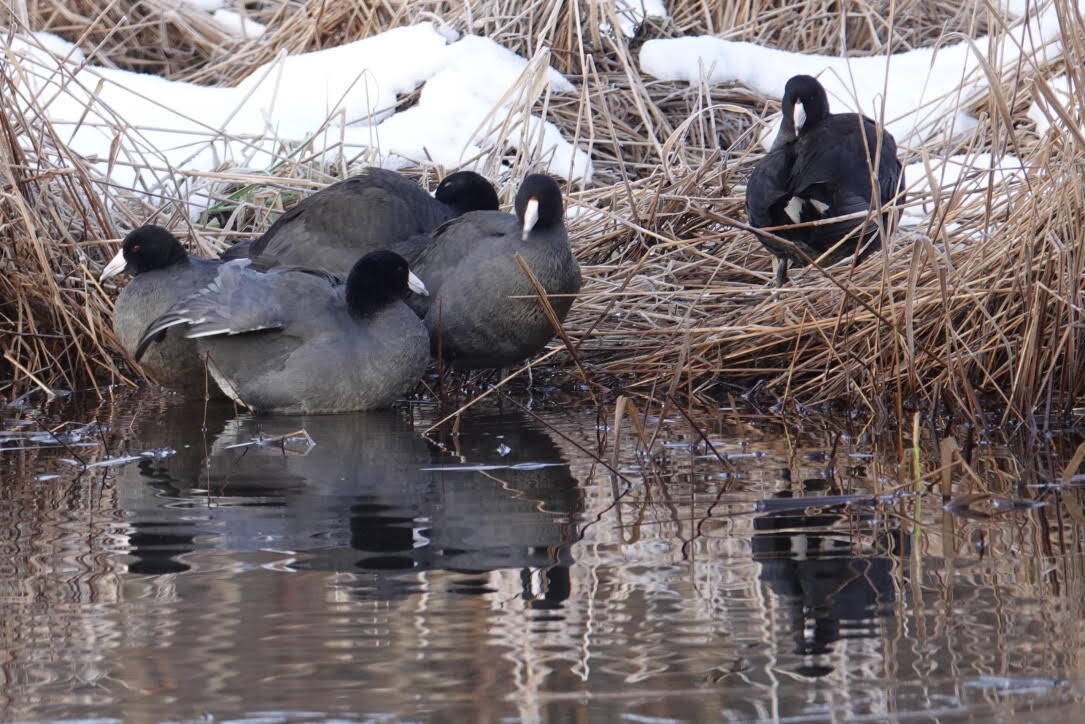Shortly before the winter solstice, I walked with a friend on the Boy Scout Camp Trail. There was a stiff, chilly breeze but — wonder of wonders — there was a big yellow thing in the sky that sent down some warming rays. And we found a few items of interest.
A raven had wandered beside the trail in several places, leaving its tracks when the snow was still soft. Some faded squirrel tracks led to cover under a dense, low-lying spruce branch. Some eagles and ravens flew overhead, and a pair of geese came by, talking all the way. A scattering of gulls worked along the distant edge of the exposed sandbars. A mysterious bird that was not a duck or a gull might have been a good-sized shorebird, but it went by too fast and perched on a stump too far away for me to know. And we heard a kingfisher along the river. Compared to most of my recent walks, this was a wealth of observed activity.
However, the previous day was, in its way, a good one too. With another friend, I walked the Airport Dike Trail in a sharp wind that made us glad for the sheltering trees along the trail. The highlight of this walk was spotting two brown creepers right next to the trail, doing their usual foraging pattern: they hitched straight up the low trunk of one tree, then flitted down to the base of the next tree, and hitched up that one. This was a treat, because I hadn’t seen one of these for ages. I trust there were lots of bugs and spiders lurking in the bark crevices.
Brown creepers are tiny birds, weighing roughly eight grams. It takes a lot of fuel to keep a high, steady body temperature, especially for small warm-blooded vertebrates. That’s because they have a relatively large surface area (where heat is lost) compared to a relatively small volume of muscle and organs (which generate heat). Despite the high metabolic cost, brown creepers are resident birds here and along the coast up to the Anchorage area. Although the coastal zone doesn’t get as cold as the Interior, an occasional period of very low temperatures can create high metabolic demands for animals such as the creepers. How do they manage??? They may sometimes roost together in small groups, in a sheltered location, but I have not found detailed information.
Chickadees have been studied in some detail. Most of the research on wintering chickadees comes from studies of black-capped chickadees, but it is likely to apply to our species also. Our chestnut-backed chickadee is a resident. It has unusually dense plumage and good insulation and can generate a bit of extra heat by shivering. Some muscles increase in size in winter, providing increased heat generation. They may put on a bit of extra fat if possible, and they are reported to have some way (no details available) to put on fat very quickly, so if they burn fat overnight, they can replace it the very next day. Sometimes they may cache a few seeds for ready consumption. They may take advantage of sheltering cavities or dense patches of conifer needles for nocturnal roosts and are said to sometimes roost in small groups. Furthermore, chickadees can temporarily increase their metabolic rate if temperatures are very low and can lower their body temperature several degrees on cold nights, thus saving energy.
We have some other very small birds that have to deal with winter too. Like creepers and chickadees, they weigh less than about 10 grams (for reference, a U. S. quarter coin weighs just over five grams); none of them is big enough to store much body fat. Golden-crowned kinglets stay here; one report says that they huddle together on a branch when it’s very cold. Pacific wrens may spend cold nights roosting together in cavities, protected from hard weather and sharing body heat. I have to wonder if these and any other small songbirds that winter here show some of the useful adjustments that chickadees can do.
Two kinds of hummingbirds occur here. Rufous hummers are said to have the longest migration of any hummer; they typically bail out to Mexico for the winter. The slightly large Anna’s hummer is an occasional visitor and may wander widely. Both species are sometimes seen here in winter, visiting feeders if available. Hummers are capable of entering torpor — letting their metabolic rates and body temperatures drop at night or when food is scarce. That would help them deal with winter, if any individuals actually stay all winter and don’t wander away from time to time. While there is circumstantial evidence of overwintering hummers, apparently there are no hard data on these hummers truly residing here all winter and on their overwinter survival.
Friends have reported other sightings of interest. Some coots have been hanging out at Kingfisher Pond, but of course they weren’t there when I went to look. Two pine grosbeaks and a dipper (oh — lucky observer!) were seen along the Treadwell Ditch. And a little flock of redpolls was seen along the dike trail; more common in the Interior, in cold weather they burrow several centimeters under the snow to make a sheltering chamber.
Two or three male mallards have been scarfing up spilled bird seed from my pond. One day as I glanced out my windows, I saw a mink galloping up over the little dam and over the slushy ice and into their midst, no doubt with predatory intentions. But it was not to be! One of the mallards took off after that mink and chased it all the way back downstream. Lunch was not to be disturbed.
• Mary F. Willson is a retired professor of ecology. “On The Trails” appears every Wednesday in the Juneau Empire.

